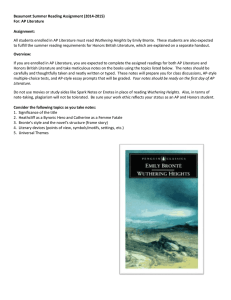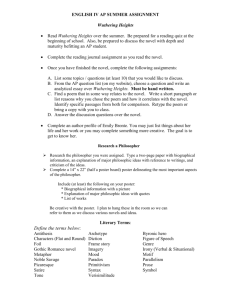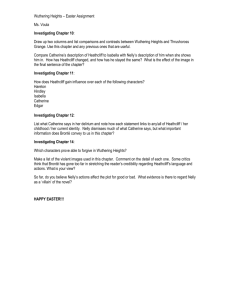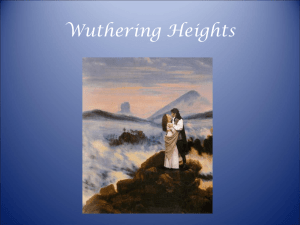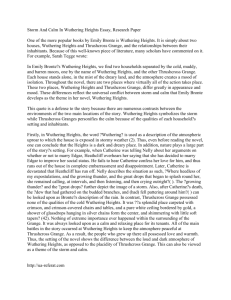The two homes in Wuthering Heights
advertisement
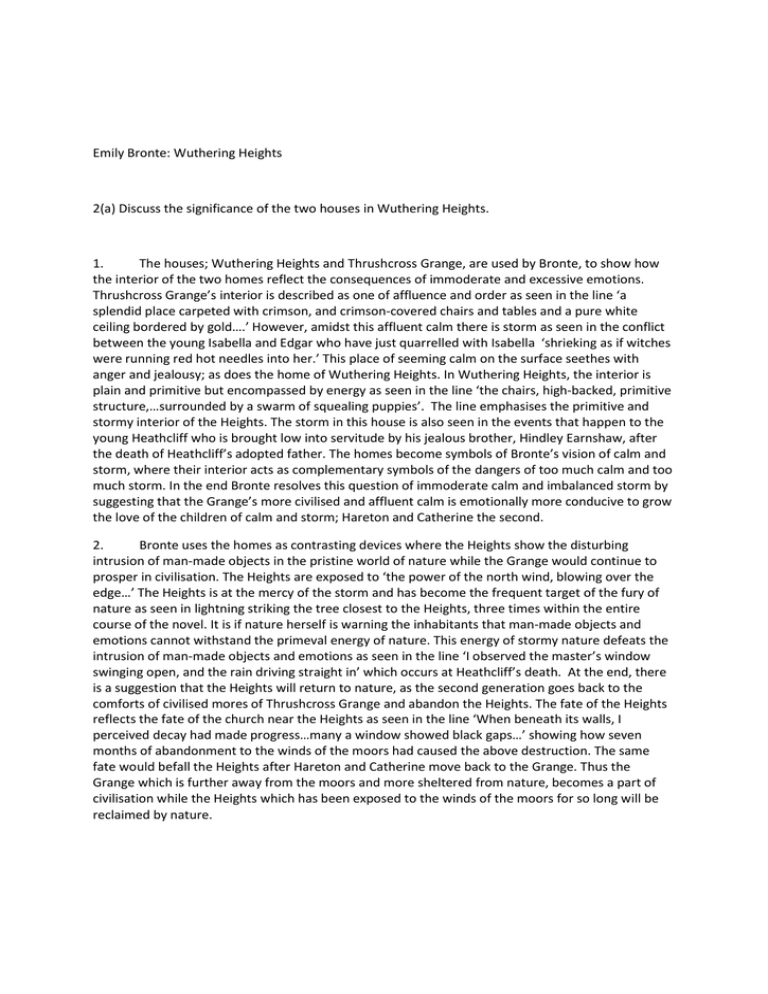
Emily Bronte: Wuthering Heights 2(a) Discuss the significance of the two houses in Wuthering Heights. 1. The houses; Wuthering Heights and Thrushcross Grange, are used by Bronte, to show how the interior of the two homes reflect the consequences of immoderate and excessive emotions. Thrushcross Grange’s interior is described as one of affluence and order as seen in the line ‘a splendid place carpeted with crimson, and crimson-covered chairs and tables and a pure white ceiling bordered by gold….’ However, amidst this affluent calm there is storm as seen in the conflict between the young Isabella and Edgar who have just quarrelled with Isabella ‘shrieking as if witches were running red hot needles into her.’ This place of seeming calm on the surface seethes with anger and jealousy; as does the home of Wuthering Heights. In Wuthering Heights, the interior is plain and primitive but encompassed by energy as seen in the line ‘the chairs, high-backed, primitive structure,…surrounded by a swarm of squealing puppies’. The line emphasises the primitive and stormy interior of the Heights. The storm in this house is also seen in the events that happen to the young Heathcliff who is brought low into servitude by his jealous brother, Hindley Earnshaw, after the death of Heathcliff’s adopted father. The homes become symbols of Bronte’s vision of calm and storm, where their interior acts as complementary symbols of the dangers of too much calm and too much storm. In the end Bronte resolves this question of immoderate calm and imbalanced storm by suggesting that the Grange’s more civilised and affluent calm is emotionally more conducive to grow the love of the children of calm and storm; Hareton and Catherine the second. 2. Bronte uses the homes as contrasting devices where the Heights show the disturbing intrusion of man-made objects in the pristine world of nature while the Grange would continue to prosper in civilisation. The Heights are exposed to ‘the power of the north wind, blowing over the edge…’ The Heights is at the mercy of the storm and has become the frequent target of the fury of nature as seen in lightning striking the tree closest to the Heights, three times within the entire course of the novel. It is if nature herself is warning the inhabitants that man-made objects and emotions cannot withstand the primeval energy of nature. This energy of stormy nature defeats the intrusion of man-made objects and emotions as seen in the line ‘I observed the master’s window swinging open, and the rain driving straight in’ which occurs at Heathcliff’s death. At the end, there is a suggestion that the Heights will return to nature, as the second generation goes back to the comforts of civilised mores of Thrushcross Grange and abandon the Heights. The fate of the Heights reflects the fate of the church near the Heights as seen in the line ‘When beneath its walls, I perceived decay had made progress…many a window showed black gaps…’ showing how seven months of abandonment to the winds of the moors had caused the above destruction. The same fate would befall the Heights after Hareton and Catherine move back to the Grange. Thus the Grange which is further away from the moors and more sheltered from nature, becomes a part of civilisation while the Heights which has been exposed to the winds of the moors for so long will be reclaimed by nature. 3. The houses are used to show the impact of class structures in society. Thrushcross Grange is posited as a place of civilisation and affluence seen through the description of its affluent interior and mannered mores of the civilised and genteel class. Wuthering Heights is described as a wild and primitive place where dogs and humans interact together in the kitchen with little regard for propriety. Catherine is seduced by the glamour of wealth and status as seen in this line ‘And he shall be rich and I shall like to be the greatest woman in the neighbourhood...’ rejecting Heathcliff’s lowly status but still in love with him. The twisted saga of the limitations of class is further seen when Heathcliff makes the owner of Wuthering Heights, Hareton, a mere rustic peasant and servant to the sham owner Heathcliff himself. Bronte uses the homes to show the effects of property as status symbols. The homes are mere shells which convey empty social conventions of class and destroy lives like Catherine and making the rich into poor servants as in the case of Hareton. 4. The houses become places where the supernatural realm impacts on the physical reality of structures. The houses are solidly set in the Yorkshire moors but within these stolid and real structures, supernatural happenings rip off the comfort of reality. Bronte forces her readers to come to terms with the idea that we live in an environment where the physical is not really known and things like ghosts, demons and the call of lost souls carried by the wind element may be possible. Bronte may convey Lockwood’s dream of Catherine’s ghost as either reality or dream as seen in the lines ‘The intense horror of nightmare came over me..’ but there is the suggestion it may be real instead of dream as seen in the use of tactile imagery of ‘ice-cold’, ‘instead of which my fingers closed on the fingers of a little ice-cold hand’. Furthermore, the physical realm is shown to be less satisfying than the supernatural realm as seen in Heathcliff’s dying hours where Nelly says she hears him speaking to ‘a person present-low and earnest- and wrung from the depth of his soul’ even though he is alone in his room. Even in the unimaginatively luxurious house of the Grange, the supernatural is able to make inroads as seen in the lines when Catherine opens her window from the Grange and claims she sees the lights of the Heights; an impossibility as said by Nelly who exclaims ‘there was no moon and everything below lay in misty darkness...those at Wuthering Heights were never visible’ and yet Catherine cries from her window at the Grange ‘that’s my room ...and the other candle is in Joseph’s garret...’. The opening of the window at the Grange seems to have invited the winds of the moors to tempt and bait Catherine to remember her home at the Heights and her lover Heathcliff. 5. The homes act as organic structures that require terrible sacrifices for them to continue in the landscapes of the moors. The Heights become a place of jealousy and struggle as the favoured adopted son replaces the true heir. The Heights are then forcibly taken away by the sham owner, Heathcliff, and the home exacts a terrible vengeance on the sham owner when the windows of Heathcliff’s room swing open to let in the cold air and take away the live of its already weakened love-sick owner as seen in the lines ‘...his face and throat were washed with rain...The lattice flapping to and fro had grazed one hand...’. Moreover, the Grange, too ,appears to be an organic structure demanding its own kind of sacrifice. Catherine dies for daring to aspire to be part of her childhood home of the Heights and the mistress of the Grange. Both homes cannot have one mistress as they belong to different realms and the Grange exacts its own kind of vengeance for Catherine’s presumed betrayal when the doors and windows of the Grange are locked against her true soul-mate, Heathcliff, ordered by the heir of the Grange, Edgar Linton. The homes become places which almost have a life of their own; exacting vengeance and sacrifice.

